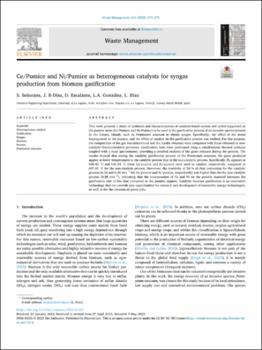Ce/Pumice and Ni/Pumice as heterogeneous catalysts for syngas production from biomass gasification.
Fecha
2023Resumen
This work presents a study of synthesis and characterization of catalysts-based cerium and nickel supported on
the pumice stone (Ce/Pumice and Ni/Pumice) to be used in the gasification process of an invasive species present
in the Canary Islands, such as Pennisetum setaceum to obtain syngas. Specifically, the effect of the metal
impregnated on the pumice, and the effect of catalyst on the gasification process was studied. For this purpose,
the composition of the gas was determined and the results obtained were compared with those obtained in noncatalytic thermochemical processes. Gasification tests were performed using a simultaneous thermal analyzer
coupled with a mass spectrometer, providing a detailed analysis of the gases released during the process. The
results showed that during the catalytic gasification process of the Pennisetum setaceum, the gases produced
appear at lower temperatures in the catalytic process that in the non-catalytic process. Specifically, H2 appears at
640.42 ◦C and 641.84 ◦C when Ce/pumice and Ni/pumice were used as catalyst, respectively, compared to
697.41 ◦C for the non-catalytic process. Moreover, the reactivity at 50 % of char conversion for the catalytic
process (0.34 and 0.38 min− 1 for Ce/pumice and Ni/pumice, respectively) was higher than for the non-catalytic
process (0.28 min− 1
), indicating that the incorporation of Ce and Ni on the pumitic material increases the
gasification rate of the char compared to the pumitic support. Catalytic biomass gasification is an innovative
technology that can provide new opportunities for research and development of renewable energy technologies,
as well as for the creation of green jobs.






